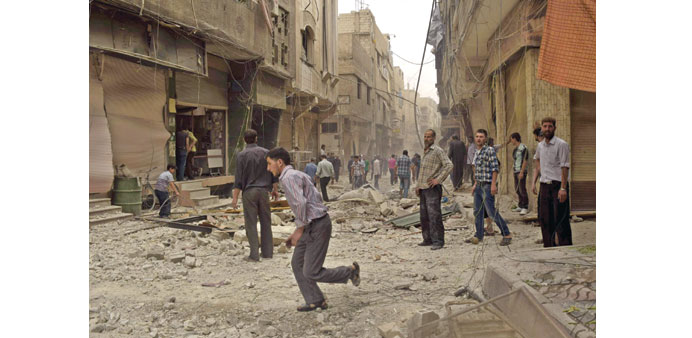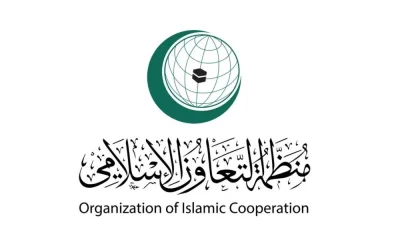Residents stand at a site hit by what activists said were air strikes by regime forces in the town of Arbeen in Damascus province yesterday.
Syria’s antiquities director says he fears the killings are a harbinger of the much-dreaded destruction of the ancient site
AFP
Beirut
The Islamic State group “executed” 20 men in front of a crowd in the Unesco-listed Roman theatre of Syria’s ancient city of Palmyra yesterday, a monitor said.
Across the border the militants claimed to have abolished when they proclaimed their “caliphate” last year, thousands of Iraqi security forces and paramilitaries deployed across Anbar province.
Nearly a week after seizing strategic Palmyra, IS gathered 20 men they accused of fighting for the regime in the ruins of the theatre and shot them dead, Rami Abdel Rahman, head of the Syrian Observatory for Human Rights, said.
“IS gathered a lot of people there on purpose, to show their force on the ground,” he said.
Syria’s antiquities director said he feared the killings were a harbinger of the much-dreaded destruction of the ancient site, considered one of the world’s greatest heritage jewels.
The militant group has damaged priceless historical sites across the region but mainly used its sledgehammers and dynamite on statues and places of worship it considers idolatrous.
IS seized Palmyra on May 21, a move analysts warned positioned the group to launch more ambitious attacks on Damascus and third city Homs.
According to the Observatory, it has over the past week executed at least 217 people, including 67 civilians, in and around the city.
In neighbouring Iraq, the government’s efforts to pressure IS in its Anbar stronghold gathered pace, with thousands of fighters deployed across the province from different directions.
Their immediate goal was to cut off the militant group’s supply lines, but some forces inched towards provincial capital Ramadi which IS captured on May 17.
The fall of the city, 100km west of Baghdad, was a huge blow to the government and its policy of building up a local Sunni force to expel IS from its bastions.
Nonetheless, 1,000 members of a newly formed Sunni unit graduated and received weapons at an event in Anbar’s Habbaniyah base that had been delayed by the fall of Ramadi.
Iraqi forces moved into Ramadi’s Taesh and Humeyrah districts and also entered the neighbouring Anbar university compound, an army colonel on the ground said.
“Iraqi security and Hashed forces took control of both neighbourhoods. They also managed to enter the university but have yet to liberate it,” he said.
Hashed al-Shaabi is an umbrella group for mostly Shia militias and volunteers that the government called in after Ramadi fell to IS.
Prime Minister Haider al-Abadi originally opposed sending them to Anbar, but the performance of the regular forces in the Ramadi debacle two weeks ago left him with few options.
It was feared that the mass deployment of groups with a record of abuses against Sunnis risked raising sectarian tensions.
After a string of setbacks in Iraq, IS’s twin offensives in Ramadi and Palmyra suggested that some had written off the militant group too soon.
Washington has insisted that the momentum had not swung, however, and that its daily air strikes were paying off.
In northeastern Syria, the Observatory’s Abdel Rahman said Kurdish forces retook Assyrian Christian villages the militants had seized earlier this year.
“Following a 10-day offensive, Kurdish fighters took control early this week of 14 Assyrian villages that IS had controlled since February,” he said.
An Assyrian rights activist said the counter-offensive in the northeastern province of Hasakeh was made possible by an intensive campaign of air strikes by the US-led coalition.



